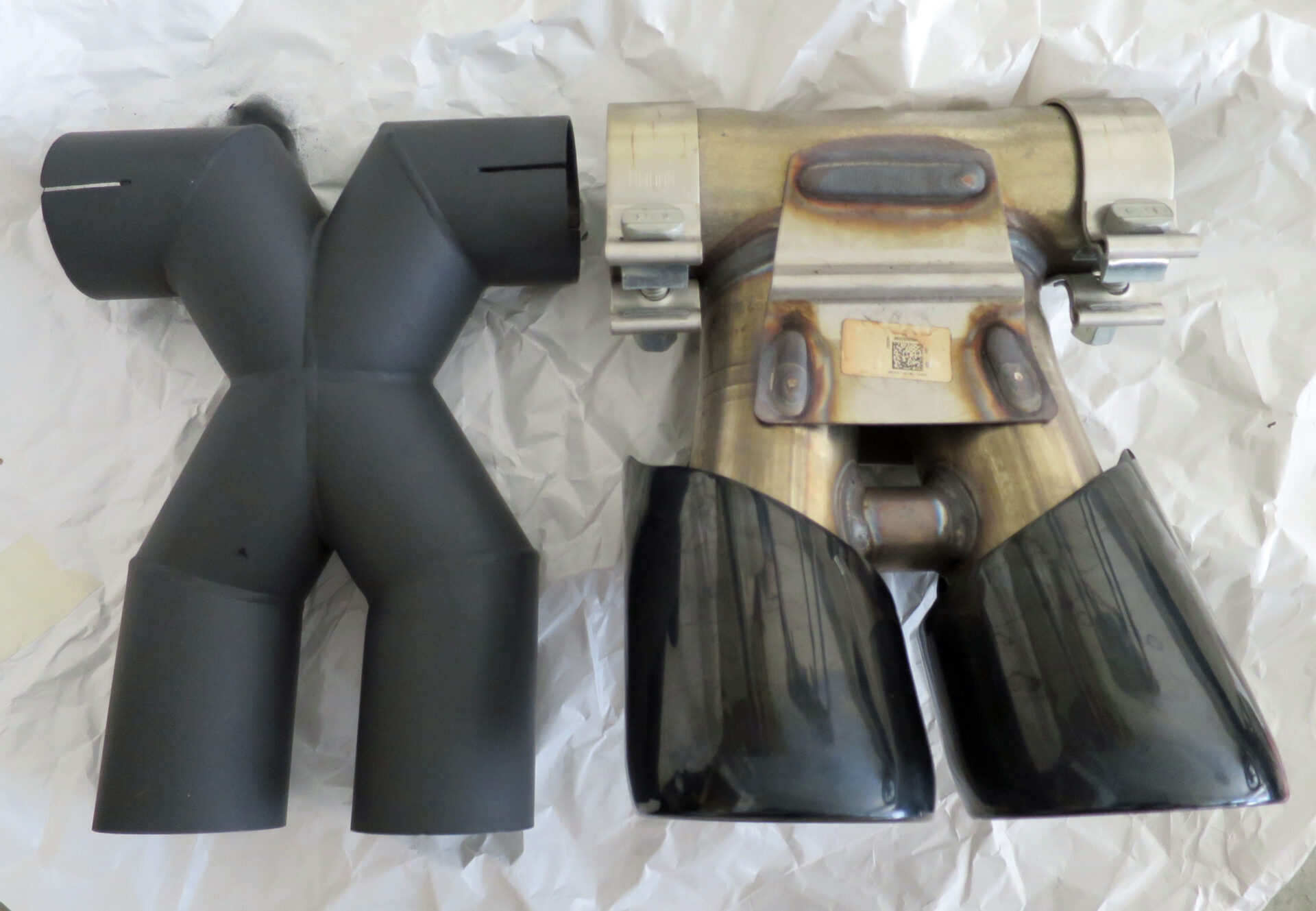The 4-cylinder turbo engines in the 718 Cayman and Boxster are not that high strung, only pushing out between 300hp-365hp. So, Porsche did not have to optimize the exhaust tip for flow and power. Any OEM is looking to save a buck or two to bring down the bill of materials cost. A dollar saved is a dollar earned? Or in this case, a dollar in the profit column. And then there is the whole deal about making stuff look cool.
 If you recall, I bought this base Cayman exhaust tip in order to start designing my own custom X-pipe.
If you recall, I bought this base Cayman exhaust tip in order to start designing my own custom X-pipe.
 I am actually quite impressed with the simplicity of its design which I think makes it quite cheap to produce. It looks to me like the main body is a single piece of stamped sheet metal that is folded over and then welded. Then the rectangular tip thing is attached by welding. The assembly is only three part numbers if you take the clamp assembly as a single part number.
I am actually quite impressed with the simplicity of its design which I think makes it quite cheap to produce. It looks to me like the main body is a single piece of stamped sheet metal that is folded over and then welded. Then the rectangular tip thing is attached by welding. The assembly is only three part numbers if you take the clamp assembly as a single part number.
 The T comes with the Sport Tailpipes stock which is otherwise a $660 option currently on the base Cayman. This part falls into the ‘looks cool’ column along with ‘make Porsche a lot of money’ column for a cosmetic upgrade. It has a fair amount of welding and higher part count driving up the cost compared to the base exhaust tip. Does it flow any better than the base tip? I doubt it. It might even flow worse, but I do think the twin round tips looks better than the single rectangular one.
The T comes with the Sport Tailpipes stock which is otherwise a $660 option currently on the base Cayman. This part falls into the ‘looks cool’ column along with ‘make Porsche a lot of money’ column for a cosmetic upgrade. It has a fair amount of welding and higher part count driving up the cost compared to the base exhaust tip. Does it flow any better than the base tip? I doubt it. It might even flow worse, but I do think the twin round tips looks better than the single rectangular one.
 This twin tip assembly has bracing plates on top and bottom along with the small connecting tube. I thought it was a cross-over flow tube, but it is purely a structural brace. Are the braces needed? Yup, I have seen pictures of an aftermarket exhaust of similar twin tube design for the Cayman without bracing. One of the tubes fell off during track use.
This twin tip assembly has bracing plates on top and bottom along with the small connecting tube. I thought it was a cross-over flow tube, but it is purely a structural brace. Are the braces needed? Yup, I have seen pictures of an aftermarket exhaust of similar twin tube design for the Cayman without bracing. One of the tubes fell off during track use.
 I really really dislike fluid flows that crash straight into each other. Which is why I had to design my own X-pipe. Yes, there are some aftermarket options, but I did not like all of their design aspects nor their costs. While my design consists of straight tubing, the angles are not all simple. How do we go about making the cuts properly? I got the idea of making sleeves to slide over the 2.5″ 304L SS tubing to mark them.
I really really dislike fluid flows that crash straight into each other. Which is why I had to design my own X-pipe. Yes, there are some aftermarket options, but I did not like all of their design aspects nor their costs. While my design consists of straight tubing, the angles are not all simple. How do we go about making the cuts properly? I got the idea of making sleeves to slide over the 2.5″ 304L SS tubing to mark them.




4 comments
Some of the aftermarket companies (I think Soul?) were claiming no power gains on the 718 with a straight piped catback exhaust. Different X pipe tip design than yours though. Any thoughts?
Anything the baby 2.0 stock turbo can put out, not going to see much with the going cat back. Maybe on the bigger S or GTS turbos. Even then, not much gains to be had in the exhaust until turbo upgrade in my opinion. The only real bottleneck in the stock exhaust is the stock cat. Replacing that with a high flow sport cat is the best place to uncork restriction. Otherwise, the downpipe is huge and then that splits into the two approximately 2.5″ exhaust pipes that go to straight through mufflers. At the exhaust tip, text book loss coefficient for a 90deg bend is 1.1. A 45deg bend is 0.4. Mine is 60deg but I think gain benefit by not having the pulsating flows crash into each. Regardless, need a tune to take advantage of any potential flow improvement at higher power levels. Otherwise the stock ECU will just keep on hitting the programmed in torque target. Or if on crap fuel, better exhaust flow should mean less knock. But for sure, the stock cat is the major bottleneck. The other bottleneck is the small compressor inlet tube. Raggdoll Motorsport has a good upgrade for that.
Nice design. A little surprised you didn’t angle the cuts on the tips. Hopefully the crossflow design helps with scavenging. I imagine there’s a slight change in exhaust note.
I thought about the slash tip for about a minute. But it added two more cuts along with another area to add error and visually see any misalignment of the tubes. I figured flat cut was good enough for a GT3 racecar, good enough for me.